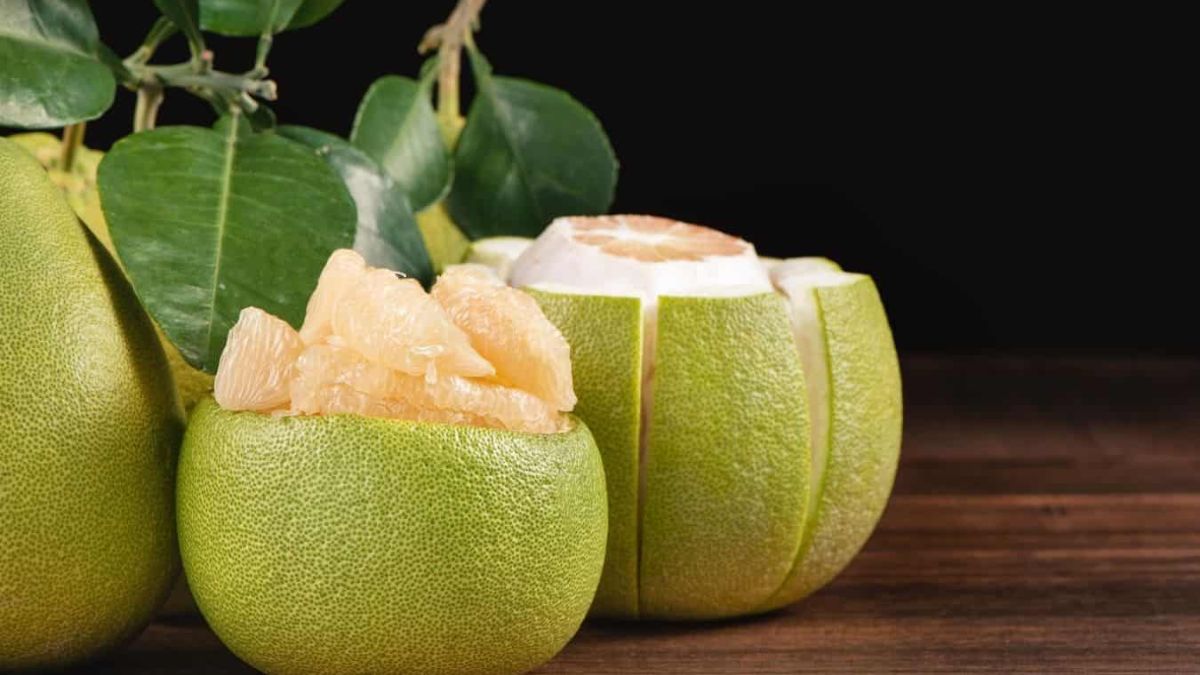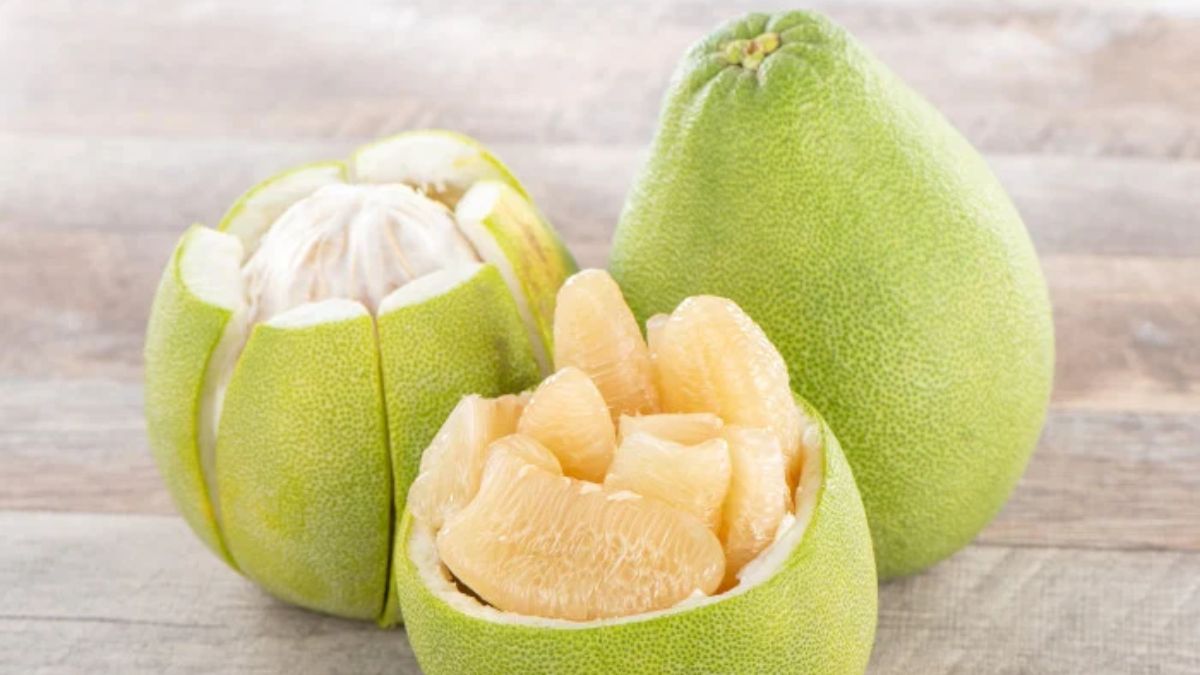Pomelos are commercially produced in Thailand (where they are known as “sum-oh”), Southeast Asia, China, Mexico, and southern California and Florida. It’s a non-hybrid citrus fruit native to Asia that’s utilized to develop the most commercially available cultivars. For example, grapefruit is a mix between a pomelo and a sweet orange. The pomelo received the title “King of Citrus Fruits” due to its size, which may grow as large as a basketball and weigh up to two pounds. Citrus maxima are its scientific name, which means “largest citrus.”
What is the purpose of pomelo? Vitamin C and other potent antioxidants are abundant in pomelo fruit. It also contains protein and fibre, which can help digestion and keep you feeling full for longer after you eat. Potassium is also abundant in this fruit. White grapefruit is larger than oranges, but pomelos are even more significant — they’re the largest citrus fruit of all. Pomelos, on the other hand, are teardrop-shaped rather than circular. Grapefruit skins are smoother and vary in colours from bright to reddish-yellow.
How to Use Pomelos?
Breakthrough the rind to open a pomelo, which can be up to two inches thick. Slice off the stem end with a sharp knife, then score it in quarters around the exterior by slicing through the skin. Remove the fruit by peeling the skin back like a banana (this may require some force). You can either toss the rind or use it to make candies, pickles, or marmalade. Remove the entire white skin from the pomelo, then cut it into parts, removing all the bitter white pith and membranes. Alternatively, you can cut it in half horizontally, like a grapefruit, and use a serrated spoon to remove the portions. The colour of the fruit will vary according to the variety/hybrid you bought.
Pomelo can be eaten raw or cooked in a sweet or savoury meal. Fresh pomelo is commonly eaten in Thailand with a pinch of salt and a dash of chilli powder or integrated into a light, acidic salad. Pomelos, like grapefruit, go well with shellfish, and their juice lends zing to marinades and vinaigrettes.
What are Pomelos?
After the sea captain, who is credited with bringing the pomelo to the West Indies, it is also known as Pamplemousse, pummelo, or shaddock. With a thick peel and few seeds, it’s the most significant and sweetest citrus fruit. Pomelos come in various colours, ranging from dark green to pastel yellow. Some have a peek at the top where the stem connects to the tree, giving them a pear form, while others are fully spherical. The inner fruit is available in various colours, ranging from white to orange to pink, and can be eaten raw or used as a garnish in both sweet and savoury recipes. Pomelos are often more expensive than oranges and grapefruits, but fans believe the investment is well worth it.
Pomelos (Citrus grandis) are citrus fruits that are related to grapefruits. Pomelos are known for their large size (up to a foot in diameter), mainly owing to the extra-thick pith—the white component of the peel beneath the rind—that makes them so significant. The rind is yellow to light green, and the flesh is yellow to pink in colour. The name “pomelo” (or “pummelo”) has unknown origins, and the name could be derived from Malay’s pumpulmas or the French word pomme. The unverified myth that Captain Shaddock was the first to bring the pomelo to Barbados in the sixteenth century gave the fruit another name, “shaddock.”
What does Pomelo Taste like?
Pomelos are citrus fruits with acidity and sourness, but they are also less juicy than grapefruits, oranges, and tangerines. They have a distinct flowery scent and taste sweet and tangy but not bitter. Pomelos come in a wide range of tartness, sweetness, and bitterness, and there are many different varieties of wild and cultivated pomelos. Pomelos, in general, have a grapefruit flavour.
Pomelo types that producers prefer (frequently available in grocery stores and farmers’ markets) have a more delicate, floral flavor than grapefruits. Honey pomelos are familiar with light yellow skin and meat and have a moderate flavour. Pomelos are frequently crossed with other citrus varieties. Pomelo and other citrus fruits have resulted in the sweet orange (a hybrid between pomelo and mandarin), grapefruit (pomelo and sweet orange), and tangelo (pomelo and sweet orange) (pomelo and tangerine).
Where to Buy Pomelos?
Fresh pomelos are available from November to March in most Asian markets and occasionally in regular supermarkets and grocery store chains, depending on where you reside. You may also buy them directly from growers online, but because of the perishable nature of the fruit, most require a two-day shipment, which adds to the already exorbitant price. On rare occasions, you might come across dried pomelo wedges in a packet or jars of pomelo marmalade. The pomelo is believed to have originated in Southeast Asia (particularly Malaysia and Indonesia) and has been cultivated in China for thousands of years. Pomelos are currently grown in tropical places worldwide, including California. The pomelo fruit is known as jabong in Hawaii.
How to Peel a Pomelo?
You can peel the pomelo’s easy-to-peel skin and thick pith with your hands, but cutting precise pomelo segments for a fruit salad is easier using a small paring knife. To open a pomelo, take off the narrow top first. Make six to eight lengthwise slits around the pomelo, cutting down into the pith but stopping short of the flesh. Because the rind and as much of the pith as possible have a bitter flavour, remove them. Cut the top and bottom of the pomelo with a sharp paring knife as close to the inner flesh as possible. Place the pomelo on the flat cut surface you just made and sliced down the skin in pieces, taking as much pith as possible.
Conclusion
A freshly harvested, unpeeled pomelo will keep in the refrigerator for about two weeks. The flesh dries up rapidly once the skin is removed; eat it immediately or freeze it. The pomelo is a significant citrus fruit that originated in Asia. You may not be familiar with it, but you’ve most likely eaten the grapefruit, its near sibling. Pomelo fruit flesh can be green or yellow, and the rind is thick and whitish. A pomelo can grow as large as a cantaloupe or slightly more prominent. It has a teardrop form and a grapefruit flavour but is slightly sweeter. Pomelo includes several components that make it a healthy food choice, including cancer-fighting antioxidants.
Vitamin C, a potent antioxidant, is abundant in pomelo and several other antioxidant substances. The primary antioxidants present in pomelos are naringenin and naringin, also found in citrus fruit. Pomelo fruit contains the antioxidant lycopene, and Lycopene is an anti-inflammatory compound found in tomatoes. Vitamin C and other potent antioxidants are abundant in pomelo fruit. It also contains protein and fibre, which can help digestion and keep you feeling full for longer after you eat. Pomelo can be used in the same way that grapefruits are. They’re great raw as a snack, but they can also be made into Pomelo marmalade the same way as orange marmalade. Fruit salad Pomelos give a zesty burst of citrus flavour to sweet and savoury fruit salads.

